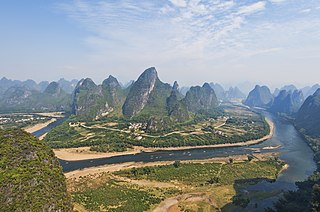
Zhang Zizhong was a general of the Chinese National Revolutionary Army (NRA) during the Second Sino-Japanese War. Born in Linqing, Shandong, he was the highest-ranked officer and the only Army group commander of the NRA to die in the war. He showed great valor in the field and was regarded as one of the most valiant and respectable Chinese generals by the Imperial Japanese Army during the Second Sino-Japanese War. Because he was lieutenant general with the effective rank of full general at the time of his death, and was posthumously promoted to full general, he was also one of the highest-ranked Allied officers killed in action in World War II. His mausoleum is situated in Beibei District, Chongqing. There are roads named after him in Shanghai, Beijing, Tianjin and Wuhan.

The Fujian People's Government is the common name for the People's Revolutionary Government of the Republic of China (1933–1934), also known as the Fujian People's Government, was a short-lived anti-Kuomintang government in the Chinese Republic's Fujian Province. The rebellion that led to its formation and its collapse are known as the Fujian Incident or Fujian Rebellion.
The 125th Division was a division deployed by the People's Republic of China during the Chinese Civil War and the Korean War. After series of redesignations and conversions, the division ends its fate as 13th Armored Brigade in April 2017.

Li Pinxian was a KMT general from Cangwu County, Guangxi. After the end of the Chinese Civil War in 1949, he immigrated to Taiwan.

Shangguan Yunxiang was a Kuomintang general from Shanghe County, Shandong. He was the brother-in-law of Kuomintang general Yu Hanmou.

Guiping is a county-level city in eastern Guangxi, China. It is under the administration of Guigang City, located at the confluence of the Qian and Yu rivers, which are the Xi River's primary north and south tributaries, respectively.

The Chinese Workers' and Peasants' Red Army or Chinese Workers' and Peasants' Revolutionary Army, renamed Chinese People's Red Army in 1936, commonly known as the Chinese Red Army or simply the Red Army, was the armed forces of the Communist Party of China from 1928 to 1937. The Red Army was incorporated into the National Revolutionary Army as part of the Second United Front with the Kuomintang to fight against the Japanese during the Second Sino-Japanese War of 1937. In the later stages of the Chinese Civil War, they were renamed the People's Liberation Army.
Events from the year 1929 in China.

Guangxi, officially the Guangxi Zhuang Autonomous Region (GZAR), is an autonomous region of the People's Republic of China, located in South China and bordering Vietnam and the Gulf of Tonkin. Formerly a province, Guangxi became an autonomous region in 1958. Its current capital is Nanning.
The Battle of Yichang was fought in western Hubei on April 11, 1929 between the armies of Sichuan and Guangxi as part of the internal conflicts within the Kuomintang leading up to the Central Plains War. Both Liu Xiang and the new Guangxi clique were nominally independent from Chiang Kai-shek's authority despite their nominal affiliation with the Kuomintang.
The 151st Division was created in November 1948 under the Regulation of the Redesignations of All Organizations and Units of the Army, issued by Central Military Commission on November 1, 1948, basing on the 10th Independent Division of Northeastern Field Army, formed in January 1948.
The Second Battle of Guangzhou was fought between the rival armies of the Liangguang region in Southern China as part of the internal conflicts within the Kuomintang leading up to the Central Plains War. The previous month, the New Guangxi clique had fought the Sichuan clique at the Battle of Yichang in Hubei. The forces of the New Guangxi clique attacked Guangzhou from both their home province of Guangxi as well as Jiangxi. Guangdong forces captured a brigade commander of the New Guangxi clique's army.
The Battle of Nanning was fought between the invading Yunnan Army, allied to Chiang Kai-shek's faction, and the defending forces of the New Guangxi clique.
The Second Battle of Guilin was fought between the invading Hunan Army, allied to the forces of Chiang Kai-shek, and the forces of the New Guangxi clique personally commanded by Li Zongren. Li was facing a second invasion by the forces of the Yunnan Army targeted at Nanning. Li was forced to withdraw his forces from Guilin.
The Battle of Xinzheng was fought between the forces of Chiang Kai-shek and Feng Yuxiang. Feng's army abandoned the neighboring city of Zhengzhou as a result. The 11th Division of the National Revolutionary Army was the first to enter the city, followed by the 47th Division and 48th Division.
The 147th Division(Chinese: 第147师) was a military formation of the People's Liberation Army of the People's Republic of China.
Da Cheng was a rebel state that existed in Guangxi, southern China, from 1855 to 1864.
Lin Shengben is a Chinese hymn composer, known for his songs composed with Chinese traditional tunes.
The northern Henan battle took place on May 27, 1929, and the location was in northern Henan, China. It was one of the civil war battles that took place inside the National Revolutionary Army. The two warring sides of the division were Han Fuju Army supported by Chiang Kaishek and Pang Bingxun Army supported by Feng Yuxiang. Han was a former subordinate of Feng while Pang had once been a commander of the Zhili clique's Wu Peifu before joining Feng.
The Chiang-Gui War was a military conflict between the Nationalist government of Chiang Kai-shek against the warlord army of Guangxi that lasted from March until June 1929. A later conflict, the 2nd Chiang Gui-War, occurred between the two opposing factions in November and December of the same year.